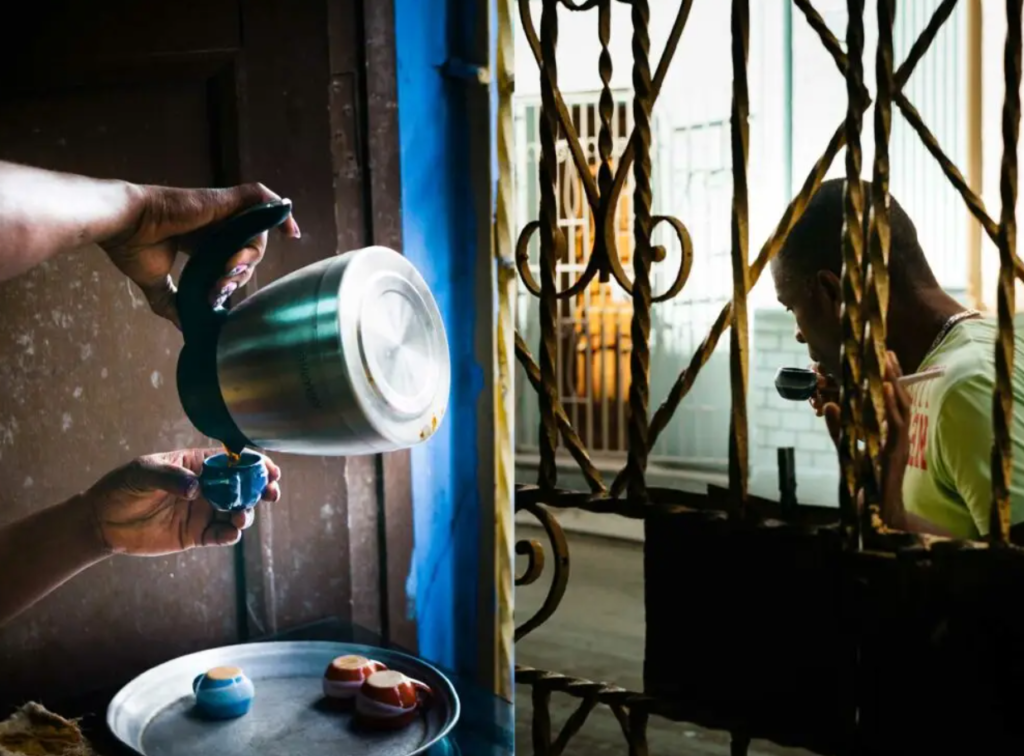
Cuban Coffee 101: From Moka Pots to Espumita
Cuban coffee has a long history. Introduced in the middle of the 18th century, coffee was rapidly developed in Cuba, and its early plantations were designated as UNESCO World Heritage Sites.
Cuban coffee culture became so embedded that even people who have never been to the island are probably familiar with the café cubano.
However, Cuba offers more than just this one special beverage when it comes to coffee.
This is the fourth instalment of our coffee culture series where we find out how coffee is grown, traded, consumed and how it shapes the social landscape of countries it’s in.
And yes, there is something we’ve found to be common; so far and it’s beautiful. Read on to find out what it is on this trip to Cuba.

Source: https://www.pinterest.com/pin/90635011244917736/
How Cubans Drink Coffee

Source: https://www.saveur.com/cuban-coffee-culture/
It’s not about the quality of beans or the type of extraction, all that matters is coffee, it is the vehicle that brings families, friends and gossip with the neighbours as their own way of keeping up with the Joneses.
Because of the coffee scarcity the government developed a rations system for coffee in 1962, which meant everyone had 4 ounces (about 113 grams) of coffee every month.
Things were not funny and people had to get creative to keep up with a lifestyle they just couldn’t stop cold turkey.
They had to get creative and they did. By mixing their 113 grams of coffee with chicharo chickpeas- Café con chícharo, or coffee with chickpeas, which is a mix of ground, toasted beans and toasted chickpeas.
This blend of creativity and an effort for coffee to get to more people, café with chícharo produces a rustic, earthy, slightly bitter brew, sweetening coffee is a typical practice.
That explains why it is difficult to find a home without a Moka Pot; it also explains how people can become resourceful.
The ventanilla or little window, originated from an abundance of homebrewed coffee. If you don’t drink coffee at home or don’t have time to visit a cafe before work, you can choose to sip your coffee outside of other people’s houses, where they sell it through open windows facing the street for 1 Cuban peso.
-
1kg Kwararafa Light Roast | Vibrant & Fruity Nigerian Coffee (Ground or Whole Bean)
-
250g Kwararafa Light Roast | Vibrant & Fruity Nigerian Coffee (Ground or Whole Bean)
-
Buna Magic Mug
-
Chemex Combo: Brewing Perfection & Kwararafa Coffee (250gms)
-
Experience Clean Coffee Perfection: TGR 151 Chemex by Tigray Coffee Co.
-
Full Control, Full Flavor: TGR 171 French Press by Tigray Coffee Co.
-
Limited-Time! Save 15% – Tigray Moka Pot & Kwararafa Coffee Combo
-
Tigray Coffee Co. French Press & Coffee Combo: Unwind in Rich Flavor (250g)
-
Unlock Italian Coffee at Home: TGR 101 Moka Pot by Tigray Coffee Co.
Cuban Coffee Growing Regions
The good thing is, coffee is still grown here in three coffee haven spots on the island: Pinar del Rio, the Escambray mountain range that has protected areas within the mountain slopes. These places are dedicated to growing only organic coffee, and the Sierra Maestra mountains—where 92% of Cuba’s coffee is cultivated.
Compared to other varieties of coffee, Cuban coffee is well-known for having a thicker texture and a robust, sweet flavour. It is traditionally created by blending sugar with finely ground strong dark coffee prior to brewing, and it is served in an espresso-like fashion.
Why Cuban Coffee is Unique
Cuban coffee can’t be predicted by its use of a Moka Pot in its preparation, there are a handful of qualities such as it sweetness, strength and other tested and trusted preparation techniques. That elevates how coffee has turned to a savouring experience rather than a pick-me-up drink, and it is mouth watery in every kind of way.
Cuban Coffee Preparation and Everything in Between
Moka Pots are the star brewers used in Cuba, which means wherever in the world coffee comes from, best believe, a Moka Pot will be used to brew a batch of finely ground roast beans. Cuban coffee in essence stands out with its use of sugar in two popular ways:
Brown sugar, also known as demerara sugar, is sometimes added to Cuban coffee to make it extremely sweet and give it a thick, almost syrup-like viscosity.
Whereas in another fashion, white sugar is used in various recipes to make sugar froth, or espumita. To make this, a tiny bit of unsweetened coffee is mixed into a thick paste with white sugar. The paste is then covered with the remaining coffee to create a froth that resembles cream on top.
When compared to drip, French press, or pour-over coffee, one cup of Cuban coffee has twice the strength. Dark espresso roasts are typically used in Cuban coffee, which contributes to its powerful flavour. Using Moka Pots to brew coffee is another contributing factor.
Since a greater amount of pressure extracts more coffee flavour than most other coffee makers. Cuban coffee appears quite dark when compared to other forms of brewed coffee. In part because it is made from dark roast beans (you can read more about this in our earlier post).

Source: https://www.pinterest.com/pin/349099408620304963/
Cuban Coffee Drinks
There are four foundations to experiencing the traditional ways of coffee you just can’t get anywhere else.
Café cubano or cafecito: While brewing, espresso Cubano is sweetened. The first few espresso drips are added to a cup with demerara sugar as soon as they appear. The mixture is beaten to produce a thick foam called espuma, the remaining espresso is added to the cup after it’s ready.
Cortadito: Is a Cubano café that has been sweetened and topped with steaming milk. The proportion of milk to espresso can range from 50/50 to 75/25, everything is all about preferences!
Café con leche: Literally coffee with milk, is usually a breakfast thing, where you have coffee with hot milk with sugar to sweeten your cup of gold.
Colado: The classic Cuban espresso, which comes with smaller cups to share with friends and is prepared to fill a large cup.
Conclusion
This UNESCO World Heritage Site, together with its people’s love for coffee and visita with the neighbours solidifies cuba’s heritage. When it comes to coffee and hospitality both to visitors and family and friends is a testament to just how good it is to having two generations long Moka Pots brew coffee anytime of the day. To sound of children playing and musicians singing and strumming their guitars on the streets on Havana.
Read our Indonesian Story here!
- Rwandan Coffee: From Farmer to Fairtrade. - August 8, 2024
- The Rise of Coffee in Thailand - August 1, 2024
- Kenyan Coffee: From Colony to Connoisseur. - July 25, 2024



No Comments